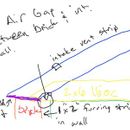Sealing top of exterior wall in vented attic
I am working on air sealing the attic of our 1940s home. It’s brick exterior with only 1×2 strapping holding the interior walls to the exterior brick with practically no insulation. Our second floor gets much colder in the winter. At the roof line, I found the gap between the exterior and interior walls is completely open. See attached drawing. Is it OK/recommended to seal those gaps? I was planning to seal the gaps by stuffing some insulation in and then spray foaming over the top to fill the gap. It’s very difficult to reach that part of the roof. Once I have the major penetrations sealed, I plan to spray the entire attic floor with spray foam before moving insultation back into place. I’m doing 1/4 of the attic at a time. I wasn’t sure if air sealing the exterior wall gaps would create moisture problems in the walls?
This is in Chicago, climate zone 5.
The attic is vented but doesn’t have a vented soffit. When we had our roof reshingled a few years ago they installed intake venting along the roof a couple feet up which then vents out closer to the ridge. When I was removing the insulation from the first section of the attic, it was pushed all the way to the edge, against the roof sheathing at the corners. Some of it was wet, unsure yet if it’s a leak (it’s been raining) or moisture buildup from being directly against the roof.
GBA Detail Library
A collection of one thousand construction details organized by climate and house part












Replies
That gap is just outside of your thermal envelope and needs to remain open to vent the space between the bricks and wood framing. Note bricks are not waterproof they absorb water and the interior side of the bricks will get wet sometimes and will need a way to dry.
Walta
Thanks Walta, why isn't the inside of the exterior walls considered part of the thermal envelope if all the holes and gaps in the walls allow conditioned air into (and presumably out of) those spaces not unlike the attic without air sealing? It would be impossible to seal everything up properly without completely gutting this old house. I thought the brick was supposed to dry out to the exterior? I'm just a homeowner so trying to understand things as best I can so we can improve the house over time. I'll avoid filling those gaps but am concerned about air leakage from the rest of the house making it into those exterior walls and up and out the attic. I'm not sure how much value air sealing the attic provides if we're still losing heat and air throughout the rest of the home.